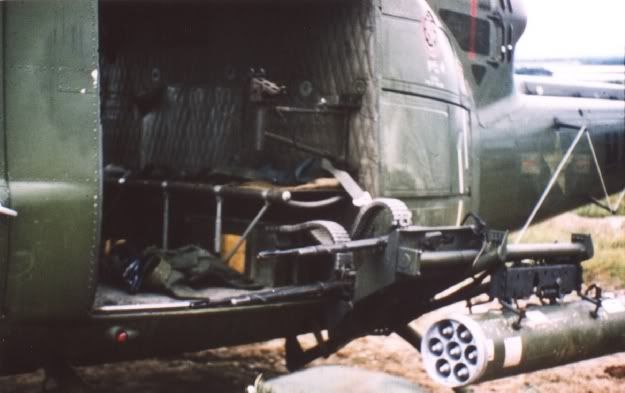I was looking though some of my kits and I noticed the way the Italeri kits are set up. The engine housing is seperate so it looks like it would be easy to swap between kits. The F has a long tail boom, short fuselage and the odd side exhaust. Since the E has a short fuselage, long tail boom and regular rear exhaust wouldn’t that make a bash with the F and a B or C kit an E or am I missing something?
I could be wrong, but I thought an E model was a modified C model to make it more suited for maritime ops. These changes included structural elements being made out of chromium as opposed to aluminum, and better seals on compartments and electronic components. Externally, it looks like any other C model. I have been told the only way to really tell them apart is from the data plate.
I could be confused then. I thought the E was sort of a hibred of the C & D with some other minor modifications the USMC requested.
No, the E was not a hybred on a C and D. It is basically a C with modifications required by the USMC
John is correct. The E was a C with a rotor brake and provisions for a roof mounted rescue hoist being the most noticeable.
Ok, I thought there had been some issue when people wanted to make an E. I guess I must have mixed up a couple of discussions.
Thanks
Aaron,
Yes, it can get confusing with the different engines used by the Air Force, longer tail booms with 48 ft. rotors, and 540 rotor system with 44 ft rotors. You just need to research the bird you are building.
Concur with all of the above except early Es had B tailbooms, rotors, etc. Later the Es were based on the C upgrades but it was possibel to see a B based E get the C rotor added on later. Make sense? Check you pictures for the bird you want to build.
Now if you are building an armed bird, there you have to start from scratch. The Marine TK-1 ordnance setup was like no other.
To further confuse the issue I have seen “B’s” with “C” tail booms.
Ok, that would make more sense to why I got the idea that there was more to the E than just a modified C. I just got mixed up with where the mix and match could come in.
Thanks, feel a bit less silly now. [:P]
Aaron,
Everyone is basically right at some level. The first batch of E’s were based on the UH-1B airframe. Subsequent E’s were based on the Charlie model airframe. Magnesium components were replaced with aluminum ones to prevent corrosion, a rotor brake was added, and a roof mounted rescue hoist on the right side. You can always tell a UH-1E, UH-1L, TH-1L, or HH-1K by the notch in the roof above the right cabin door. Even if the rescue hoist is missing. As the Marines are the only branch to have flown the Echo, any Marine short bodied Huey should be an Echo.
Here are some pics to help out this discussion.
Early Echo built on B frame. Note nose mounted pitot, bell mouth intake, fuel filler on right side, 204 rotorhead with blade counterweights, and rescue hoist. also note the TK-2 (Temporary Kit-2) armament system with the M-60’s staggered inboard. :
Here’s what most Echo’s look like. Note roof mounted pitot, left handed fuel filler, 540 rotor head, Particle separator and rescue hoist. No armemant installed on this one, but the TK-2 kit was used on most Vietnam UH-1E’s:
Finally, here’s a pretty good pic of the TK-2 kit Quad M-60C’s inboard, 7 shot 2.75 inch rocket pods outboard:
[/img]
I hope these help.
Ray
Supercobra,
The 540 rotor system required a different hydralic system than a standard B model rotor system. So it was a Depot level upgrade, not just a rotor head swap. Then the tail boom would have been changed out also. It acutally would have required the entire plylon assy changed out since the rotaing ring, drive links, swash plate, and scissors assy were all different. The B’s main rotor pitch horns were leading edge and the 540 trail edge. The hydraulic dampers also attach on the opposite side of the stabilizer bar. If you look closely at the mast assy you will see a roughly 3 inch spacer below the top boot on top of the scissors assy of the 540 system. Most people over look this and the different swash plate ears, and shape of the rotating ring. I can’t seem to cut and past the link to my Photobucket album pictures on the computer at work the past few weeks. When I get home I"ll post some shots of the pylon assemblies to show the difference.
As an aside to Mel’s info. You would always be able to tell a UH-1E that had originally been built on the B model airframe by the right handed fuel filler and probably nose mounted pitot (although I have heard of the pitot being moved). I would say that the UH-1B always has a right handed fuel filler, but I know of at least two UH-1B’s built for the Australian Navy that have left handed fillers (I have the pics to prove it!). Also, there are multiple documents that point to at least six UH-1B’s that were modified with the 540 rotorhead during testing of the 540 system. These include three airframes that received the 540 rotor upgrade only and not the widened cambered tail fin or the asymmetrical sync elevators. These odd birds are the Huey holy grail for me at the moment. ANY photos of these birds would be welcomed. I have pics of the YUH-1D that was modified with a 540 head and broke all the world records, but not a single image of the “540 B model” Anyway, just thought I’d throw that in. Any pics of UH-1E’s upgraded from the B configuration to the C configuration would also be great to see.
Ray
Didn’t mean to imply it was just the head that changed but then again I’m pretty sure I’ve heard stories of early Es getting the 540 system but not getting the new boom. I’ll have to go back and check some references. Also, the Marines did get some actual UH-1Bs from the Army so not every short-bodied Marine Huey was an E.
I never say never, but it was found very early on that the cambered tail with wider chord and assymetrical sync elevators were necesary additions to 540 equipped birds. That’s why only 3 UH-1B’s were ever outfitted that way.
As for the Marines recieving Army B models, I’d love to see the pics or at least the refs. I can find no documentation of the Marines recieving B models. my guess would be a ref that referred to the first batch of 204 based Echos as “B’s” but I’m always open to new info.
Ray
Here are a couple of things that might interest the diehard Huey fans. The first is a listing of Bell Configurations for the Huey compiled at Bell. I’m just posting the page with the UH-1E listed. you’ll note that construction number 6068 (serial number 151873) and subsequent recieved the 540 rotor system. That means that about 77 birds with 204 heads were built.:
the next two pages are from a Bell compiled history of the company. You’ll note that on March 3, 1962, the UH-1E won the Marines ASH (Assault Support Helicopter) competition and on Feb 20, 1964, the first UH-1E was delived to an operational Marine unit. I’d bet that if the Marines flew any Army B’s it was for a very short time and I’d also be willing to bet they were mainly used for training. I would love to see a B with Marines on the side though.
Supercobra,
No Sweat, GI! I have heard that the first Gunships the 174th AHC had were actually called UH-1B-540’s. This would support the installation of the 540 rotor systems to UH-1B’s. However the pictures of the early Sharks show a left hand fuel filler and cambered fin tailboom, all the ear marks of a actual “C”. The only other possibility is that they trained with the UH-1B-540’s and received the “C’s” to go into combat with. With the whole idea of a letter desigination I feel to have used the “E” on an actual “B” just because it was used by the Marines just donesn’t make sense. All the maintenance manuals are writtem by Type, Model, and Serial Number. Talk about confusion having a “B” and it’s called an “E” but we used the “B” manuals and “B” parts. We all know “historians” get their facts wrong every now and then but once it’s printed it never seems to get “undone”. I don’t doubt there were “B” airframes with 540 rotor systems and some with the “C” tail booms and these were called “C’s”. I also feel these were very few. I do dispute that any “B’s” flown by the Marines were ever called “E’s”.
Mel,
Robert Brackenhoff also mentioned the 540 B’s being flown by the 174th, but, like you, I have never seen photo evidence of this. However, there definitely was at least one UH-1B’ equipped with the 540 rotor system (and I’ve heard of at least 6). Check these two document summaries from the Defense Technical information Center:
http://oai.dtic.mil/oai/oai?verb=getRecord&metadataPrefix=html&identifier=AD0804242
http://oai.dtic.mil/oai/oai?verb=getRecord&metadataPrefix=html&identifier=AD0811781
ALL UH-1E’s can be distinguished from an Army UH-1B or C (although not from other short bodied Navy Hueys) by the rotor brake and rescue hoist housing (at least on all historical aircraft photos, see Mel’s pic below) and divot in the right cabin roof. I have never seen this not be the case although someone may prove me wrong. This is based on hours of research into the topic, but then again, I wasn’t there either. As i say, I could be wrong and have been before, but i’m pretty confident here.
Ray
Ray,
I edited my last the last two line of my previous post to clear up my my beliefs. I agree with you, I saw a UH-1E just last month the one belonging to the Collins Foundation and it was a Vietnam combat veteran flown by a Medal of Honor winner. It had the divot in the roof for the externally mounted rescue hoist and the rotor brake.
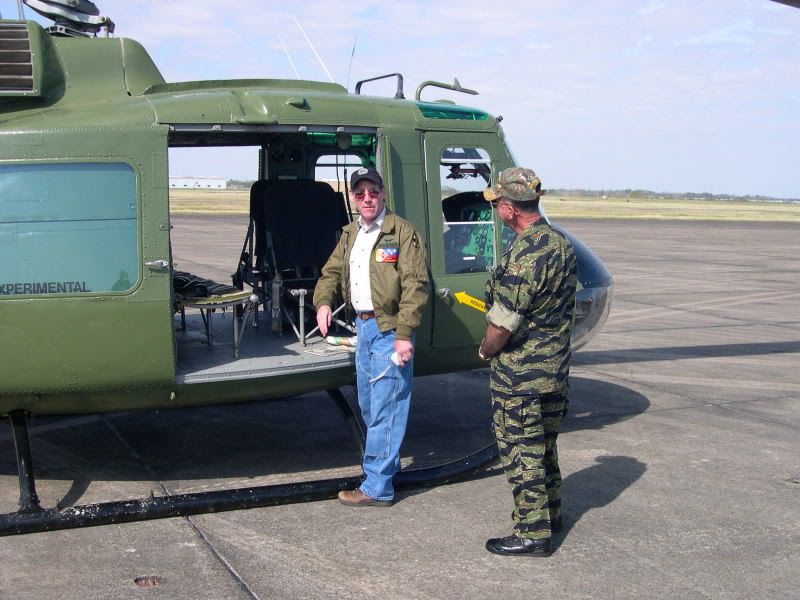
Mel,
That is too cool! I wish i could have seen that bird. Did you take any more photos? Thanks for posting that one. I see the rescue hoist housing was removed, but at least the divot is still there. You happen to know the serial?
Ray
Here are some pictures of the UH-1H plyon assy and UH-1C. The “H” and “B” are pretty much identical. As you can see the “C” is similar but the attachment points on the swashplate are different as well as shape of rotating ring. The MRC/Academy UH-1C kit has the “B” swashplate, rotating ring, scissors, and collective levers.
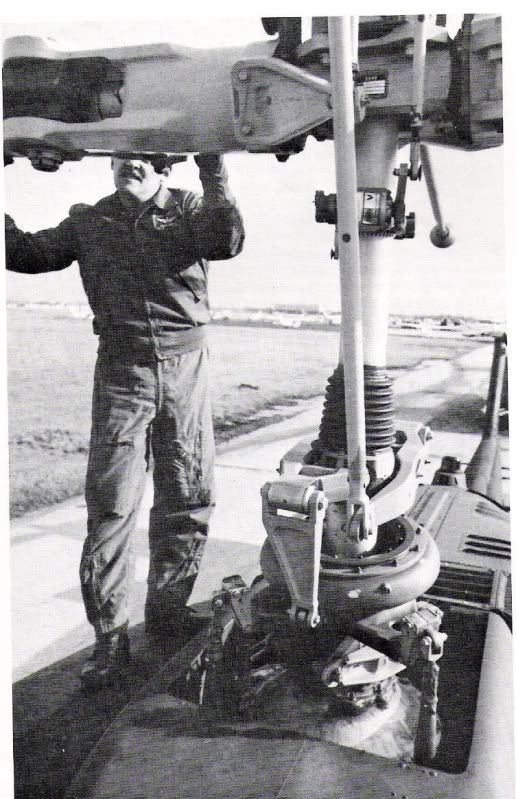
UH-1H Pylon Assy Notice the trunion type attach points of the front cyclic control tubes, and lower drive link trunions to rotating ring which is curved (half donut shapped). Also top boot sits directly on top the scissors assy.
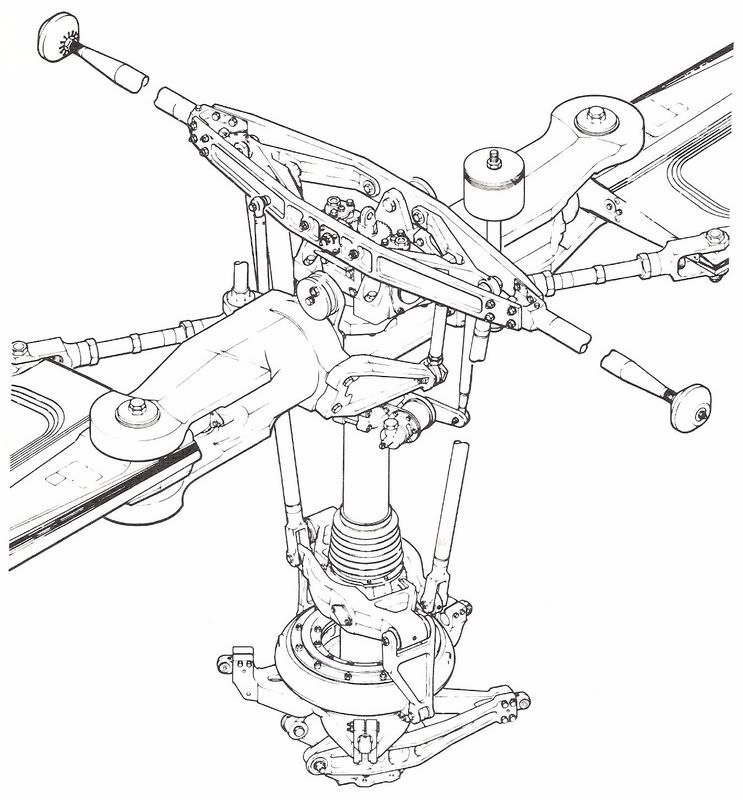
UH-1B Pylon Assy Same as an H but has the counter weights on the blade grips.
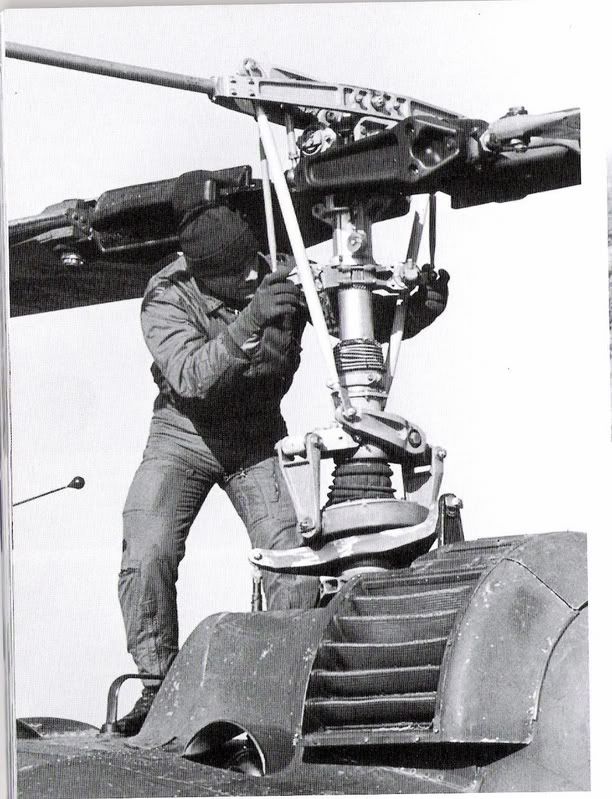
UH-1C Pylon Assy Notice the rod end type bearing on the cyclic control tubes which attaches to ears on the swashplate, the drive link has a bearing which attaches to the rotating ring which is thicker and has more of a squared off up and lower surface. The scissors are beefy with recesses in arms. The aft swashpate attachment ear attaches to a drive line type instead of the small control tube on the B and H. The stabilizer dampers are rotated clockwise about 90 degrees from the position on the H. Spacer on top of scissors assy then has boot attached to it. I don’t have a good shot of extended collective levers but you can see a portion of them in my previous post in picture of the UH-1E. They attach to forward right edge of transmission instead of lower swashplate support mount.
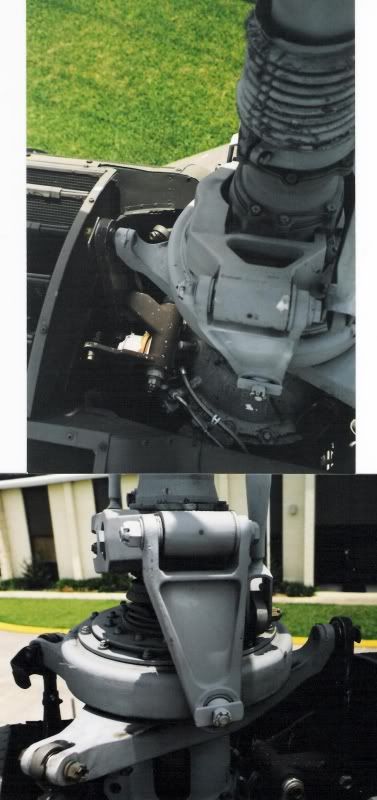
UH-1C Pylon Assy The dark “ear” sticking out to the left of the right swashplate cyclic control tube is a bracket for a coil spring that is found on C’s, D’s and H’s. Not sure about the B’s but probably so. You can see it in the top picture vaguely.
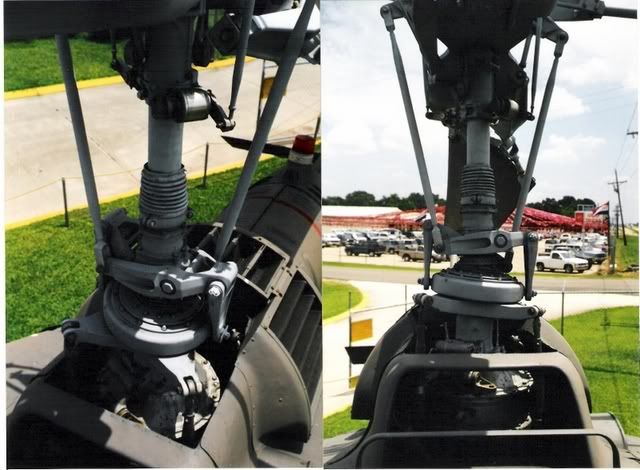
UH-C Pylon Assy The collective levers are missing from this assy. You can see the forward piviot bracket though on edge of transmission. If you modify the front ears of the MRC/Academy swashplate to the “ears” it will also help out with locating the cylic control tubes futher aft to a more correct location.
